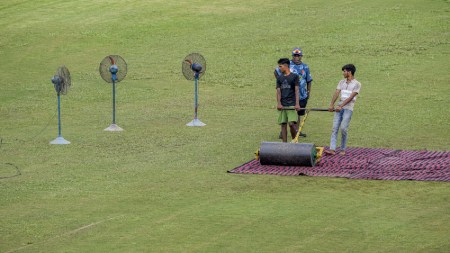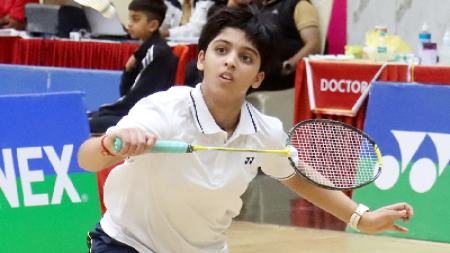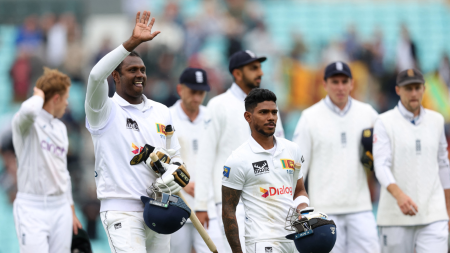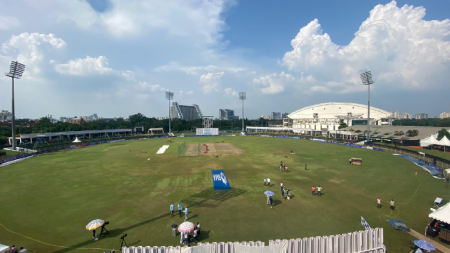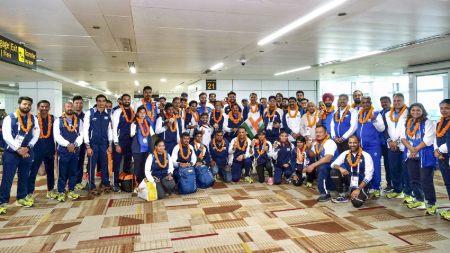‘It’s God-made connection’ How visually-impaired Simran Sharma paired with her guide Abhay Singh to win bronze medal in 200m at Paralympics
A few days before the World Para Athletics Championships in Kobe, Simran Sharma, the visually impaired sprinter, travelled to Bhubaneswar to team up with her guide. But the talented 100 metre and 200m specialist Animesh Kujur, the first choice, had an extremely busy training schedule. So Abhay Singh stepped in as the replacement. The partnership has been successful.
Simran won a bronze in the 200 metres at the just concluded Paralympics. Running alongside her at the Stade de France was Abhay, just like he had done when Simran became the World Champion in May. Simran, 24 and Abhay, 18, shared the podium and both received medals.

“This is a big stepping stone for me. I consider the Paralympics on par with the Olympics. My aim is to qualify for the Los Angeles Olympics too. Try and win a medal in both,” Abhay, the guide, said. He is inspired by Brazil’s Gabriel Garcia, a member of Brazil’s men’s 4x100m relay at the Olympics who also ‘guided’ Jerusa Geber dos Santos to gold in both the 100m and the 200m at the Paralympics.
Abhay is no ordinary athlete.
Simran clocked a personal best of 24.75 seconds to finish third. Abhay is the Under-18 national record holder in the 200 metres, has a personal best of 21.08 seconds and is an Asian Youth bronze medalist. But at the Paralympics his job is tricky, even the smallest error can cost the country a medal.
Abhay is the faster athlete but at no point can he give Simran a competitive advantage, he can’t dictate the pace of the race and must avoid what is called slingshotting, hurling the arm forward to pull the para athlete along. Simran must get across the finish line first or they get disqualified.
Abhay must ‘release’ Simran during the last 10 metres but it is not as easy as it sounds. “I can’t suddenly slow down because then it will break her stride pattern. But if I don’t slow down fast enough, there is a risk of me going ahead of her at the finish line. We both need to run in rhythm which is the key,” Abhay said. They both get a pair of starting blocks, so both need to be still before the gun goes off.
Simran gives half the credit for her bronze to Abhay. “The role of the guide is crucial. Two athletes are running, like two half-bodies but it should be like one. The role is 50-50 and both can’t make a mistake,” Simran said.
The first time they ran together in Bhubaneswar they clicked.
“It is a God-made connection. There was a great connection between our hands. We trained a lot after that of course. It takes at least a year for an athlete and guide to be synchronized but we started running together just five months ago,” Abhay said. Abhay is five feet and seven inches tall, Simran five feet and four inches — the three-inch height difference isn’t an impediment in a smooth run, both insist.
Till late 2021 Simran was classified in the T13 class, visually impaired but not allowed to use a guide. But she was struggling to stay in her lane because she couldn’t see the markings clearly. If she focussed too hard, her vision was such that she could see the lane markings shifting.
She was eventually reclassified in T12, which gives athletes the option of using a guide.
“I need a guide so that I don’t run outside the designated track. I don’t realise that I have changed the track. I have got disqualified in the past (for lane infringement),” Simran said.
She was a preterm baby, born at six and a half months. From the time she can remember she has had poor eyesight. She has an angled posture when on track because the tilt of the head helps her see a little better.
“I used to struggle to read and study as a child because the letters would shift shape. I used to watch from the side after going close. Doctors said this (vision) will not get better. If my stress level goes up I see less, if I am fatigued I see less,” Simran said. “When I run the 100 metres, the track also has markings for the 200 metres… so many lines so I get confused. If I focus too much on one specific thing then it starts to move a lot.”
Though she won a bronze in the 200 metres, Simran was devastated when she finished fourth in the 100 metres. She felt strain in the groin and the hamstring after the heats. She has torn a muscle in a competition once when she pushed too hard and was worried. In four days she was scheduled to run six races at the Paris Paralympics.
“Once I felt the strain, I was wondering how I would run the remaining five races. Mentally pressure was there. I was terribly sad after not winning a medal in the 100 metres. But I decided that even if I break my leg I don’t care, I will give it my all in the 200 metres. The 100 metres final was in the night and the next morning was the 200 metre heats,” Simran said.
Abhay blames himself too for Simran not finishing on the podium in the 100 metres. It wasn’t his best race, he said. The two of them were heart-broken, but Simran’s husband and coach Gajendra Singh told them not to cry about spilt milk. Simran recalled the pep talk. “We were depressed after the 100 metre final but my husband spoke to us and motivated us. I didn’t think of the groin pain during the 200 metre final. Just focussed on winning a medal,” Simran said.
Abhay and Simran are aiming for the stars. Simran has set her sights on a sprint double gold at next year’s World Para Athletics Championships. Abhay is dreaming of nothing less. His personal goal — break the Under-20 national record in the 200 metres.
Disclaimer: The copyright of this article belongs to the original author. Reposting this article is solely for the purpose of information dissemination and does not constitute any investment advice. If there is any infringement, please contact us immediately. We will make corrections or deletions as necessary. Thank you.
